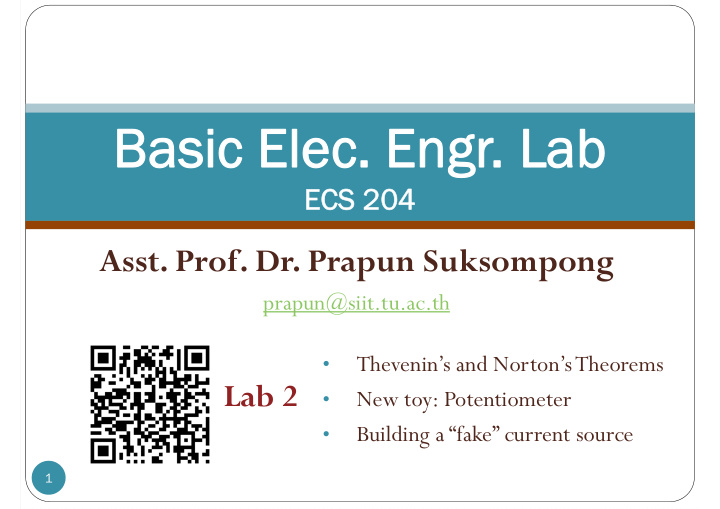



Basic Elec. Engr Basic Elec. Engr. Lab . Lab ECS 204 ECS 204 Asst. Prof. Dr. Prapun Suksompong prapun@siit.tu.ac.th Thevenin’s and Norton’s Theorems • Lab 2 New toy: Potentiometer • Building a “fake” current source • 1
Lab 2: Circuit under consideration Direct measurement of I L (A.4) 2
Outline of the lab Part A (Thevenin Eq.) Load resistor Part B (Norton Eq.) 3
Part A: Thevenin Equivalent (1) Part A voltage divider R 3 (A.12) V V TH ps R R R 1 2 3 (A.13) / / R R R R 3 1 2 TH V (A.14) TH I L R R TH L 4
Part A: Thevenin Equivalent (2) Part A Directly measure V TH (A.5) and R TH (A.8) deactivated Source(s) V Build (Thevenin) equivalent circuit to measure I L (A.11) 5
Part B: Norton Equivalent (1) R R N TH V (B.6) ps I N R R 1 2 R N (B.7) I I L N R R L N Part B 6
Part B: Norton Equivalent (2) Note that the ammeter itself acts as a short A circuit. Directly measure I N (B.2) Build (Norton) equivalent circuit to measure I L (B.5) Part B 7
Lab 2: Summary Part A (A.14) (A.11) (A.4) (B.7) Part B (B.5) 8
Need resistor whose value can be Lab 2: Summary adjusted arbitrarily Part A (A.14) (A.11) (A.4) (B.7) Need current source Part B (B.5) 9
Potentiometer (Pot) 10
Pot as a variable resistor Manually adjustable resistor Three terminals The resistance between the middle terminal and either of the two sides depends on the position of the wiper. 11
A Current source I S V PS We do not have current source. Again, it is meaningless to connect an ammeter directly across the power supply. This will NOT give you the amount of current produced by the power supply. We use a voltage source (power supply) to give the specified amount of current. I N pot 13
Recommend
More recommend